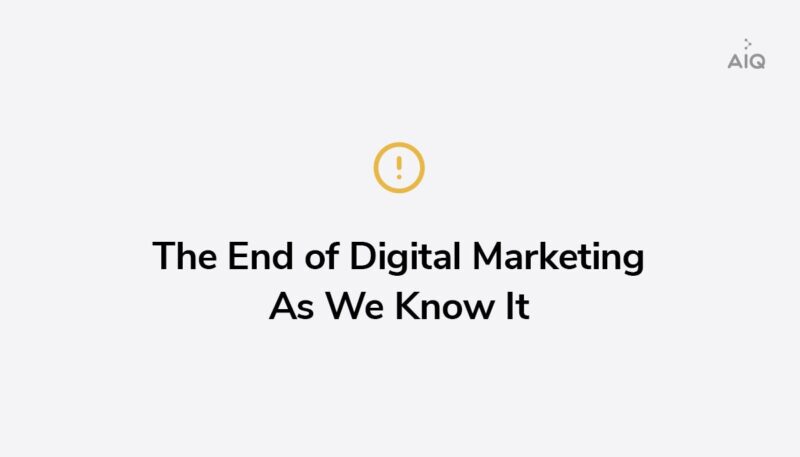Is Digital Marketing Dying?

The End of Digital Media and Marketing As We Know It
“We live in an age of manipulation. An extensive network of commercial surveillance that tracks our every move and a fair number of our thoughts.” So reads the opening line of a recent Wired Magazine article questioning the effectiveness of micro-targeted advertising and whether we’re on the cusp of an ad tech bubble set to burst.
If you’re a marketer investing in digital media to drive awareness and nurture prospects, this threat is very real and existential. Your bubble may in fact be bursting sometime in the next 12-24 months. Apple is in the process of dealing a severe blow to the surveillance economy, taking a direct shot at retargeting and attribution (primarily via Facebook and Google) upon which so many marketers have become dependent on showcasing their digital content and reaching their target audience.
Retargeting and attribution are critical practices that sit at the heart of modern digital marketing. To understand just how fundamental these processes are to modern digital marketing, let’s take a look at an example.
The Foundation of Digital Marketing
Let’s pretend I’m an F100 insurer and you are in the market for new home insurance. My crack performance marketing team, and their considerable budget, ensured that in the course of your research (conducted on your mobile phone), you came across my brand through our compelling digital content or advertisement. You paid a visit to my website. The Facebook and Google pixels on my website helped track your interactions across every click. And based on your initial interest in my insurance products, I retargeted you on each digital platform with personalized advertising. As industry leaders, we have evolved our marketing strategy to cater to our audience, allowing us to create specific ads whether you are searching on Facebook, Twitter, YouTube, or any other online platform.
Powering a Sophisticated Buyer Journey
A week and a half later, you came back and looked at pricing information, and I moved you into a new segment that receives different personalized advertising reflecting your deeper position in the marketing funnel. Two weeks later, you come back to the site one more time, request a quote, and then sign up for insurance. You download our mobile app to manage your account. We did it—you’re a customer, and our marketing efforts were a success.
My performance marketing team spent a lot to get you here. Through attribution, they can understand which ads and messages worked, which didn’t, and more effectively allocate their future spend. Getting better at what we do all the time.
Optimizing Ad Spend
Now that you’ve converted, I immediately suppress you from future acquisition campaigns, saving a ton of cost in my team’s acquisition programs or lead generation campaigns. You’ll be messaged about cross-sells, upsells, and renewal reminders through Facebook and Google retargeting as well as direct communications over email, app, and wherever else you go on the internet. Each time you convert on a new offer, I immediately move you into a new segment with the next offer, cross-sell, upsell or service to drive you to become a more loyal customer.
Through attribution, I’ll also know what works & what doesn’t, and iteratively fine-tune my approach for maximum yield. As compared to what it cost to acquire you as a customer in the first place (from a pool of hundreds of thousands of prospects), we’ll get 10x the yield on our marketing dollars this way—retargeting is simply our highest performer when it comes to getting the most out of performance marketing investments.
The Facebook and Google Tax
For sophisticated enterprises who’ve built customer journeys such as these, the ability to target, retarget, personalize and attribute using third-party platforms such as Facebook and Google is a marketer’s nirvana (and conundrum). One that grosses Facebook alone a whopping $65B in ad revenue, and comprises 40% or more of an individual brand’s digital marketing budget.
But it’s all going away.
Sweeping Changes Threaten to Upend Critical Marketing Processes
Apple, which commands 61% of the mobile market in the U.S.—and commands an even greater proportion of disposable income—is making significant changes to its approach to privacy. These changes will have drastic, sweeping effects on marketers. They include:
Shortened retargeting windows
JavaScript-set cookies will have a window of 24 hours of inactivity before being reset. Beyond seven days, marketers will be unable to see which channels, creatives and messaging contributed to each conversion. Attribution, a/b testing, and the ability to distinguish new visitors from returning will be hamstrung.
Tracking limited to a single-pixel event
If a user does not opt-in to data sharing, Apple will limit marketers to a single-pixel event. The majority of marketers will likely use conversion but they are going to lose out on every other pixel event they use to build retargeting audiences e.g. add to cart, view product, view category, initiate checkout. Audiences that are today using these pixel events will be completely lost. Any business that does significant retargeting will be severely impacted. For those users who do opt into data sharing, Apple will be limiting pixel events to 8 total—significantly fewer than the 100’s to 1000’s large brands utilize today.
Inability to track/target individuals across mobile apps
Beginning with iOS 14, Apple will make participation in IDFA opt-in for users. It’s expected 20% or less will choose to opt-in, effectively killing IDFA as a method for targeting and attribution across mobile apps. To learn more about the impact of these changes to IDFA, read What’s Apple’s Changes to IDFA Mean for Marketers.
Delayed reporting
Data sent back to Facebook from Apple will be delayed up to 3 days. That means that if a user converts on their mobile device in Safari (which accounts for 50% of mobile browsing traffic) by clicking on a Facebook ad, Facebook will not know they converted until 3 days later. Only then can they be moved to a different audience. Ad suppression and other personalization techniques that save costs and improve the customer experience will be significantly impaired.
Marketers Must Brace for Significant Impact
How big is the impact of these changes on marketers? Take this excerpt from unicorn Bumble’s recent IPO filing:
We also rely on FB for targeted ad and performance marketing. In the event that we are no longer able to conduct targeted ad and performance marketing through FB, our user acquisition and revenue stream may be materially adversely affected.” – Bumble’s S-1, January 15, 2021
These impacts will be felt not only by digital-natives such as Bumble, but also by every brand that does retargeting through Google and Facebook. In short—everyone.
Marketers’ inability to retarget, attribute and understand return on advertising spend (ROAS) down to a granular level will result in a significant rise in media spend waste. For instance, it will be difficult to create clean exclusion lists that suppress new customers from acquisition lists—meaning marketers will be wasting money on acquisition ads to existing customers.
How Can Marketers Prepare for the New World?
To survive in the face of these sweeping changes, marketers must prepare to take control of their own destiny and adapt their digital marketing strategy:
Invest in your own customer data
Marketers must reduce dependence on 3rd party data, and invest more in first-party data and authenticated identities. This means improving your processes around collecting behavioral data for digital profiles on your properties and using it to deeply understand each prospect’s and customer’s wants, needs, and preferences.
PII is the future
If you have an email address or a mobile number, you can retarget on all the big platforms (i.e. Facebook) without relying on 3rd party pixels. That means placing new emphasis on collecting PII from prospects. Many companies do this today with the help of content, free trials, loyalty programs, and subscription models—traditional brands will benefit from exploring such models to establish direct relationships with consumers prior to the first transaction.
Transform your operating model
Investing in an operating model designed around customer experiences—anchored by data and brought to life by your people, processes, and technology—will make your business resilient in the face of dynamic markets and shifting consumer preferences. It also delivers real top-line and bottom-line results. (Learn how by reading the eBook True Cost of Your Technology Choices).
Succeeding in this new era of privacy means taking back ownership of your relationships with prospects and customers. Achieving this means making an organization-wide commitment to put the customer at the center of everything you do. And harnessing the data that tells and guides the story of your customer relationships.
Cross the Chasm with a Customer Data Platform
At Action IQ, we deliver the technology that helps make it happen. (And we help with the people and process part, too). ActionIQ’s customer data platform (CDP) is designed to implement a customer-centric marketing strategy based on making the most of your first-party data. With a CDP you can:
- Bring together all your customer data, providing your CX professionals with governed access to everything you know about your customer
- Empower your teams with customer analytics and the tools they need to design and execute personalized marketing strategies—including retargeting
- Orchestrate authentic customer experiences, across all channels tailored to your prospects & customers, wants, needs and preferences
Start Taking Control of Your Customer Relationships Today
ActionIQ’s technology and experienced team can help deliver on your strategy to take control of your customer relationships and achieve a lasting competitive advantage. For a complimentary consultation with one of our top experts, please contact ActionIQ today.





